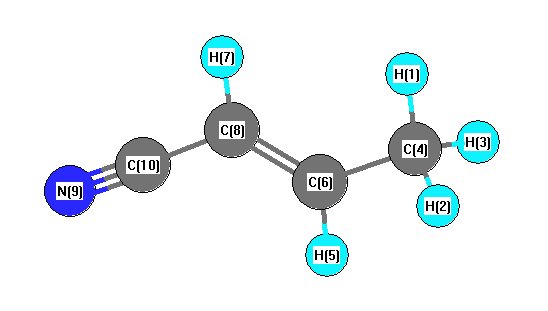Geometric Data

Point Group Cs
Internal coordinates
distances (r) in Å, angles (a) in degrees, dihedrals (d) in degrees
These cartesians were determined using some assumed coordinate values.
Cartesians
| Atom |
x (Å) |
y (Å) |
z (Å) |
| H1 |
2.6175 |
0.4411 |
0.0000 |
| H2 |
2.6243 |
-1.1004 |
0.8900 |
| H3 |
2.6243 |
-1.1004 |
-0.8900 |
| C4 |
2.2587 |
-0.5882 |
0.0000 |
| H5 |
0.2722 |
-1.5707 |
0.0000 |
| C6 |
0.7577 |
-0.5948 |
0.0000 |
| H7 |
0.5199 |
1.4533 |
0.0000 |
| C8 |
0.0000 |
0.5056 |
0.0000 |
| N9 |
-2.5953 |
0.4444 |
0.0000 |
| C10 |
-1.4316 |
0.4718 |
0.0000 |
Atom - Atom Distances 
Distances in Å
| |
H1 |
H2 |
H3 |
C4 |
H5 |
C6 |
H7 |
C8 |
N9 |
C10 |
| H1 |
|
1.7800 | 1.7800 | 1.0900 | 3.0899 | 2.1288 | 2.3290 | 2.6183 | 5.2128 | 4.0492 |
| H2 |
1.7800 |
|
1.7800 | 1.0900 | 2.5584 | 2.1288 | 3.4267 | 3.2028 | 5.5156 | 4.4400 |
| H3 |
1.7800 | 1.7800 |
|
1.0900 | 2.5584 | 2.1288 | 3.4267 | 3.2028 | 5.5156 | 4.4400 |
| C4 |
1.0900 | 1.0900 | 1.0900 |
|
2.2162 | 1.5010 | 2.6816 | 2.5096 | 4.9626 | 3.8395 |
| H5 |
3.0899 | 2.5584 | 2.5584 | 2.2162 |
|
1.0900 | 3.0341 | 2.0940 | 3.5047 | 2.6599 |
| C6 |
2.1288 | 2.1288 | 2.1288 | 1.5010 | 1.0900 |
|
2.0619 | 1.3360 | 3.5103 | 2.4353 |
| H7 |
2.3290 | 3.4267 | 3.4267 | 2.6816 | 3.0341 | 2.0619 |
|
1.0810 | 3.2745 | 2.1845 |
| C8 |
2.6183 | 3.2028 | 3.2028 | 2.5096 | 2.0940 | 1.3360 | 1.0810 |
|
2.5960 | 1.4320 |
| N9 |
5.2128 | 5.5156 | 5.5156 | 4.9626 | 3.5047 | 3.5103 | 3.2745 | 2.5960 |
|
1.1640 |
| C10 |
4.0492 | 4.4400 | 4.4400 | 3.8395 | 2.6599 | 2.4353 | 2.1845 | 1.4320 | 1.1640 |
|
Calculated geometries
for C
4H
5N ((E)-2-Butenenitrile).
Experimental Bond Angles (degrees) from cartesians 
| atom1 |
atom2 |
atom3 |
angle |
|
atom1 |
atom2 |
atom3 |
angle |
| H1 |
C4 |
H2 |
109.472 |
|
H1 |
C4 |
H3 |
109.472 |
| H1 |
C4 |
C6 |
109.470 |
|
H2 |
C4 |
H3 |
109.472 |
| H2 |
C4 |
C6 |
109.470 |
|
H3 |
C4 |
C6 |
109.470 |
| C4 |
C6 |
H5 |
116.700 |
|
C4 |
C6 |
C8 |
124.300 |
| H5 |
C6 |
C8 |
119.000 |
|
C6 |
C8 |
H7 |
116.700 |
| C6 |
C8 |
C10 |
123.200 |
|
H7 |
C8 |
C10 |
120.100 |
| C8 |
C10 |
N9 |
180.000 |
Bond descriptions
Examples: C-C single bond, C=C, double bond, C#C triple bond, C:C aromatic bond
| Bond Type |
Count |
| H-C |
5 |
| C-C |
2 |
| C=C |
1 |
| C#N |
1 |
Connectivity
| Atom 1 |
Atom 2 |
| H1 |
C4 |
| H2 |
C4 |
| H3 |
C4 |
| C4 |
C6 |
| H5 |
C6 |
| C6 |
C8 |
| H7 |
C8 |
| C8 |
C10 |
| N9 |
C10 |












